Table of Contents
Pregnancy and postpartum physiotherapy is one of the most effective yet under-discussed aspects of maternal health. Becoming a mother is one of life’s most transformative experiences, but it also places extraordinary demands on your body. While prenatal care and pediatric checkups are standard practice, many new moms don’t realize that pregnancy and postpartum physiotherapy can be a game-changer for their recovery and long-term health. Pregnancy and postpartum physiotherapy is a specialized form of treatment that addresses the unique physical challenges women face during and after pregnancy. Whether you’re currently pregnant, just gave birth, or months into your postpartum journey, understanding how pregnancy and postpartum physiotherapy can support you is essential for a healthy recovery and return to your active lifestyle.

In countries like the USA, UK, and Canada, where awareness of women’s health is growing, physiotherapists are playing a crucial role in helping new moms recover safely and confidently. This blog explores why pregnancy and postpartum physiotherapy is so important, the conditions it addresses, and the exercises and treatments that can make recovery smoother.
What is Pregnancy and Postpartum Physiotherapy?
Pregnancy and postpartum physiotherapy, also called women’s health physiotherapy or pelvic health physiotherapy, is a specialized branch of physical therapy focused on the unique musculoskeletal and pelvic floor changes that occur during pregnancy, childbirth, and the postpartum period.

Unlike general physiotherapy, pregnancy and postpartum physiotherapy addresses conditions specific to pregnancy and childbirth, including:
- Pelvic floor dysfunction
- Diastasis recti (abdominal separation)
- Pregnancy-related back and pelvic pain
- Postpartum recovery challenges
- Bladder and bowel control issues
- Pain during intercourse
- C-section recovery
Pelvic health physiotherapists undergo additional training to understand the complex changes your body experiences during this time and can provide targeted treatments that general practitioners might not address.
Why Pregnancy and Postpartum Physiotherapy Matters
Pregnancy changes a woman’s body in remarkable ways, but it also introduces unique challenges:
Hormonal changes: Relaxin loosens ligaments, making joints unstable.
Postural shifts: The growing belly alters balance and strains the spine.
Pelvic floor stress: Muscles stretch during pregnancy and delivery.
Abdominal separation: Known as diastasis recti, it affects core strength.
C-section recovery: Scars can cause adhesions, stiffness, and pain.

Without guided rehabilitation, these issues may persist for years, affecting mobility, confidence, and even mental health. Pregnancy and postpartum physiotherapy helps women restore function, prevent complications, and feel stronger in their daily lives.
Pelvic Floor Therapy in Pregnancy and Postpartum Physiotherapy
One of the most critical aspects of recovery is pelvic floor rehabilitation. These muscles act like a hammock, supporting the bladder, uterus, and bowel. During pregnancy, they bear additional weight, and childbirth can cause trauma or weakness.

Signs You Need Pelvic Floor Therapy
Leakage when coughing, sneezing, or laughing
A feeling of heaviness in the pelvis
Pain during intimacy
Constipation or difficulty controlling bowel movements
How Physiotherapists Help
Teaching correct Kegel exercises (most women do them incorrectly without guidance)
Using biofeedback tools to monitor muscle activation
Applying manual therapy for scar tissue or muscle tightness
Reconnecting breathing and core mechanics to support recovery
Common Pregnancy-Related Conditions That Pregnancy and Postpartum Physiotherapy Can Address
Pelvic Girdle Pain and Symphysis Pubis Dysfunction (SPD)

Pelvic girdle pain affects up to 80% of pregnant women to some degree. This condition causes discomfort in the pelvic joints, particularly around the pubic symphysis (the joint at the front of your pelvis), sacroiliac joints, or throughout the pelvic region.
Symptoms include:
- Sharp pain in the pubic area
- Difficulty walking or climbing stairs
- Pain when rolling over in bed
- Clicking or grinding sensations in the pelvis
- Pain that radiates to the hips or thighs
Pregnancy and postpartum physiotherapy treatment for pelvic girdle pain includes manual therapy, targeted exercises to stabilize the pelvis, advice on movement modifications, and the use of support belts when appropriate. Many women find significant relief through physiotherapy, allowing them to remain active throughout their pregnancy.
Lower Back Pain During Pregnancy

Lower back pain is one of the most common complaints during pregnancy, affecting approximately 50-70% of expectant mothers. The growing baby, shifting center of gravity, hormonal changes that loosen ligaments, and increased weight all contribute to back discomfort.
A pregnancy physiotherapist can help by:
- Teaching proper posture and body mechanics
- Providing exercises to strengthen core and back muscles
- Offering manual therapy techniques for pain relief
- Recommending safe stretches and modifications
- Suggesting sleeping positions and pillow placement
Addressing back pain early in pregnancy can prevent it from becoming chronic and affecting your postpartum recovery.
Carpal Tunnel Syndrome

Surprisingly common during pregnancy, carpal tunnel syndrome causes numbness, tingling, and pain in the hands and wrists due to fluid retention and hormonal changes. Physiotherapists can provide splinting recommendations, nerve gliding exercises, and ergonomic advice to minimize symptoms.
Round Ligament Pain
The round ligaments support your growing uterus, and as they stretch, they can cause sharp, stabbing pains in the lower abdomen or groin. While usually not serious, a physiotherapist can teach you movements and positions that minimize this discomfort.
Critical Postpartum Conditions That Pregnancy and Postpartum Physiotherapy Can Help
1. Diastasis Recti (Abdominal Separation)
Diastasis recti occurs when the two sides of the rectus abdominis muscle (your “six-pack” muscles) separate along the midline during pregnancy. Some degree of separation is normal and necessary to accommodate your growing baby, but significant separation can persist postpartum.

Signs of diastasis recti include:
- A visible bulge or doming down the center of your abdomen when you engage your core
- A gap you can feel between your abdominal muscles
- Lower back pain
- Poor posture
- Feeling of abdominal weakness
A pregnancy and postpartum physiotherapy specialist can assess the width and depth of your separation and create a progressive exercise program to help your abdominal muscles come back together. Contrary to popular belief, traditional crunches and sit-ups can actually worsen diastasis recti, which is why professional guidance is crucial.
2. C-Section Recovery
Nearly 1 in 3 births in the USA, UK, and Canada is via C-section. Recovery isn’t just about the incision healing — scar tissue can affect mobility.

Physiotherapy Approach: Scar massage, abdominal mobility work, and progressive core strengthening.
Exercise Example – Glute Bridge:
Lie on your back with knees bent.
Slowly lift your hips while engaging your core.
Hold for 3 seconds, then lower.
Repeat 8–10 times.
3. Pelvic Floor Dysfunction
Your pelvic floor is a group of muscles that support your bladder, uterus, and bowel. During pregnancy and childbirth, these muscles are significantly stretched and may become weakened or damaged.

Pelvic floor dysfunction can manifest as:
Urinary incontinence: Leaking urine when you cough, sneeze, laugh, jump, or exercise (stress incontinence) or suddenly needing to rush to the bathroom (urge incontinence). Despite being common, affecting up to 45% of postpartum women, urinary incontinence is not normal and should be addressed.
Pelvic organ prolapse: When one or more pelvic organs (bladder, uterus, or rectum) drop from their normal position. This can cause a feeling of heaviness, bulging, or pressure in the vagina.
Pain during intercourse: Painful sex after childbirth can result from scar tissue, muscle tension, or pelvic floor dysfunction.
Bowel dysfunction: Difficulty with bowel movements, anal incontinence, or hemorrhoids.
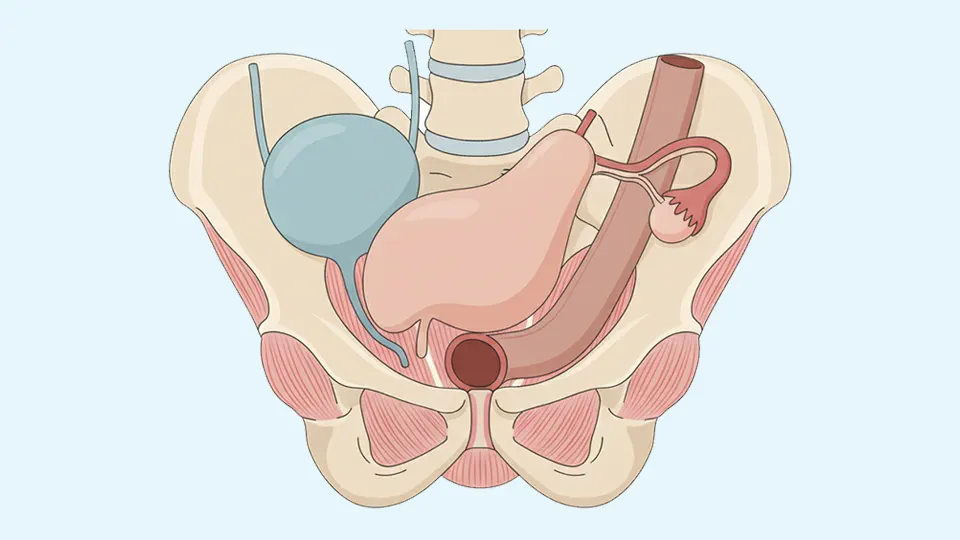
Pregnancy and postpartum physiotherapy includes internal examinations (when appropriate and with your consent) to assess muscle strength, coordination, and any areas of tension or weakness. Treatment involves exercises, manual therapy, biofeedback, and education about proper breathing and movement patterns.
4. “Mom Posture” and Musculoskeletal Pain

Caring for a newborn involves countless hours of feeding, holding, and carrying your baby in positions that can strain your neck, shoulders, and back. “Mom posture” rounded shoulders, forward head position, and upper back pain—is incredibly common.
Pregnancy and postpartum physiotherapy addresses these issues through:
- Ergonomic education for feeding and baby care
- Strengthening exercises for postural muscles
- Stretching tight chest and neck muscles
- Manual therapy for pain relief
- Movement pattern retraining
When Should You Seek Pregnancy and Postpartum Physiotherapy?
During Pregnancy
You don’t need to wait until you’re in pain to see a physiotherapist. Ideally, you should consider a pregnancy and postpartum physiotherapy assessment:
- In your first trimester to learn safe exercises and prevent common issues
- Immediately if you develop pelvic or back pain
- In your third trimester to prepare your body for labor and learn perineal massage techniques
- Anytime you have concerns about movement, exercise, or pain

After Birth
The postpartum period is when pregnancy and postpartum physiotherapy becomes particularly crucial. Consider scheduling an appointment:
6-8 weeks postpartum: This is an ideal time for a comprehensive postpartum assessment, even if you feel fine. A physiotherapist can check for diastasis recti, assess pelvic floor function, and clear you for exercise progression.
Immediately if you experience:
- Urinary or fecal incontinence
- Pelvic pain or heaviness
- Painful intercourse
- Significant back or joint pain
- Concerns about your C-section scar
- Difficulty with basic movements or exercise
Before returning to high-impact exercise: Running, jumping, and high-intensity workouts place significant stress on your pelvic floor and core. A physiotherapy assessment can ensure your body is ready for these demands, typically not before 12 weeks postpartum at minimum.
In many countries including the UK, Canada, and increasingly in the US, postpartum physiotherapy assessments are becoming standard care, similar to your 6-week OB-GYN checkup.
What to Expect During Your Pregnancy and Postpartum Physiotherapy Appointment
Initial Assessment
Your first appointment will typically last 45-60 minutes and includes:
Medical history: Discussion of your pregnancy, labor, delivery, current symptoms, and health goals.
Physical examination: Assessment of your posture, movement patterns, abdominal muscles, and overall strength and flexibility.
Pelvic floor assessment: If appropriate and with your consent, an internal examination to evaluate pelvic floor muscle strength, coordination, and any areas of dysfunction. This is typically done vaginally and sometimes rectally. You can decline this assessment if you’re not comfortable, and the physiotherapist can still help you with external assessments and exercises.
Goal setting: Discussion of what you want to achieve through physiotherapy.
Treatment plan: A customized program based on your specific needs.
Ongoing Treatment
Subsequent appointments focus on:
- Progressing your exercise program
- Manual therapy techniques
- Monitoring your improvement
- Adjusting your treatment plan as needed
- Answering questions and providing education
Most women see their physiotherapist every 1-4 weeks, depending on their condition and needs.
Treatment Approaches in Pregnancy and Postpartum Physiotherapy
Pelvic Floor Exercises (Kegels and Beyond)
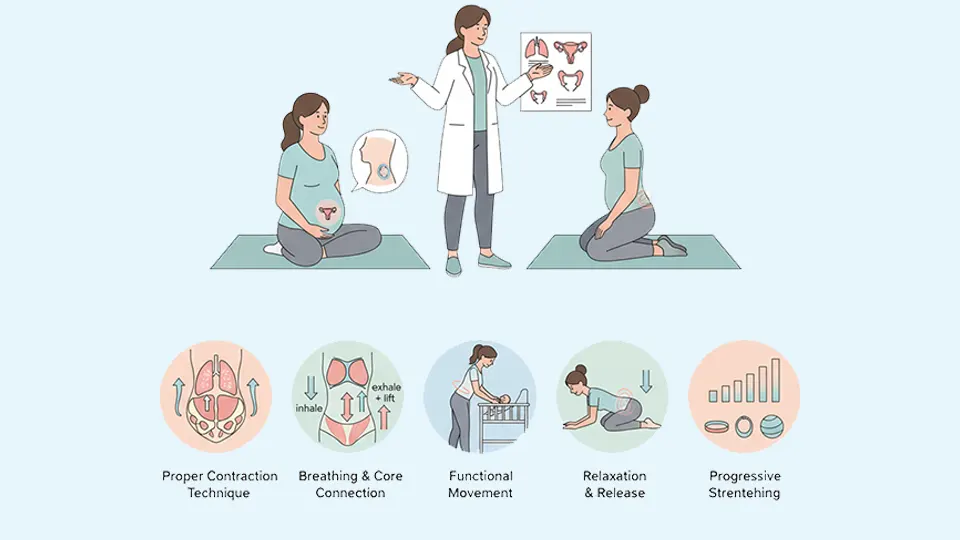
While Kegel exercises (contracting and relaxing the pelvic floor muscles) are well-known, effective pelvic floor rehabilitation goes far beyond basic Kegels. Your pregnancy and postpartum physiotherapy specialist will teach you:
- Proper technique for pelvic floor contractions
- Coordination with breathing
- Integration with functional movements
- Relaxation techniques (some women have overly tight pelvic floors that need to relax, not strengthen)
- Progressive strengthening programs
Core Rehabilitation
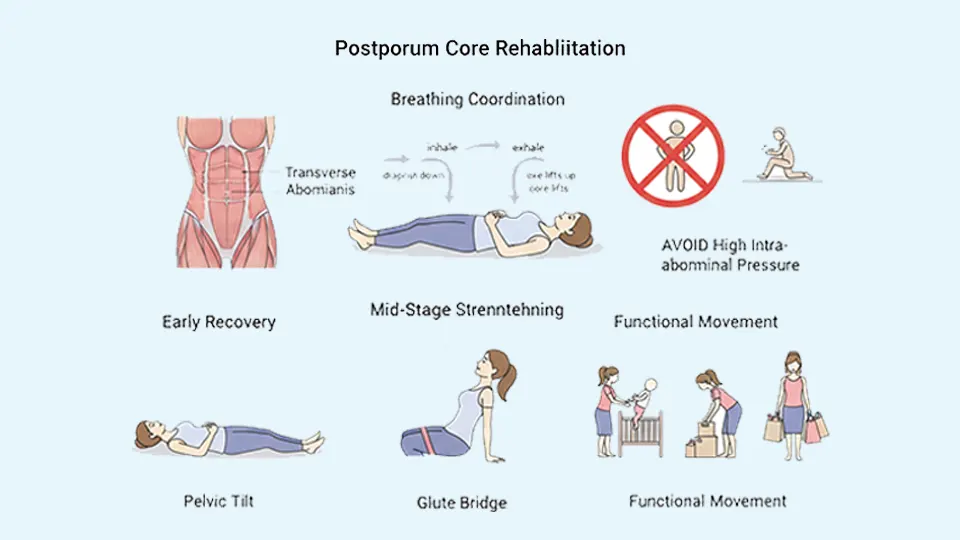
Postpartum core rehabilitation focuses on:
- Deep core muscle activation (transverse abdominis)
- Breathing coordination
- Gradual progression from basic to advanced exercises
- Avoiding exercises that increase intra-abdominal pressure excessively
- Functional movement patterns for daily activities
Manual Therapy
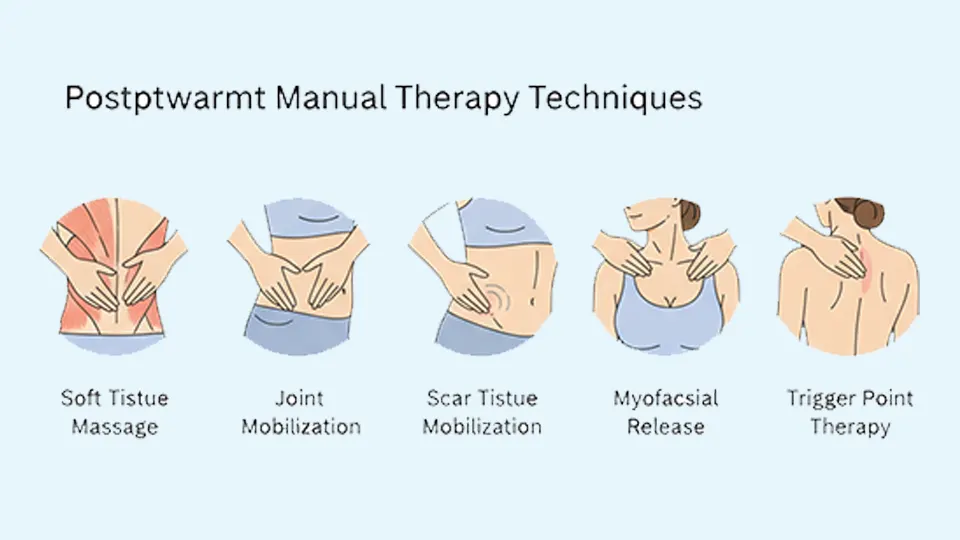
Hands-on techniques can provide significant relief:
- Soft tissue massage for tight muscles
- Joint mobilization for restricted movement
- Scar tissue mobilization
- Myofascial release
- Trigger point therapy
Education and Self-Management
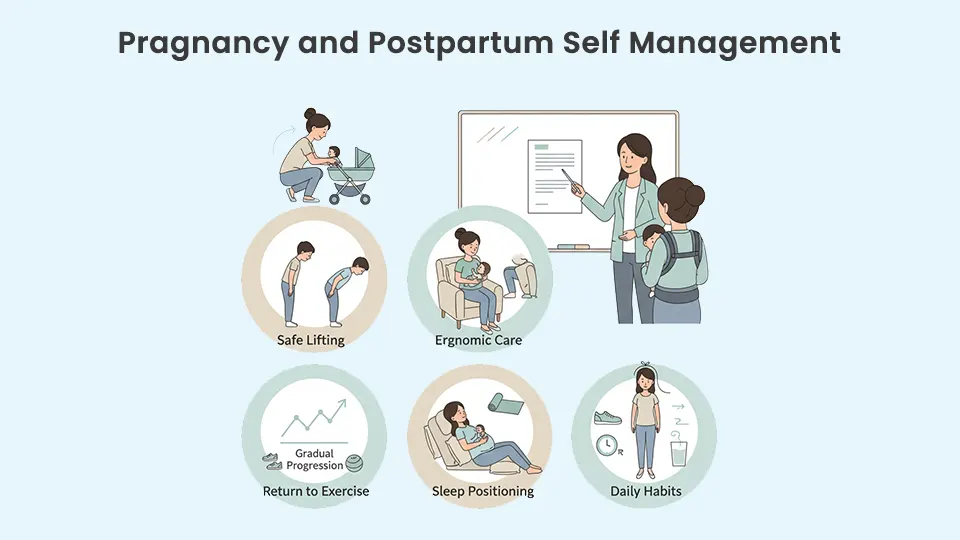
A crucial component of pregnancy and postpartum physiotherapy is teaching you to manage your own recovery:
- Safe lifting and movement techniques
- Positions for feeding and baby care
- Sleep positioning
- Return to exercise guidelines
- Lifestyle modifications
Safe Return to Exercise After Pregnancy and Postpartum Physiotherapy
One of the most common questions new moms ask is, “When can I start exercising again?” The answer depends on multiple factors, but rushing back to high-intensity exercise can cause or worsen pelvic floor dysfunction and diastasis recti.
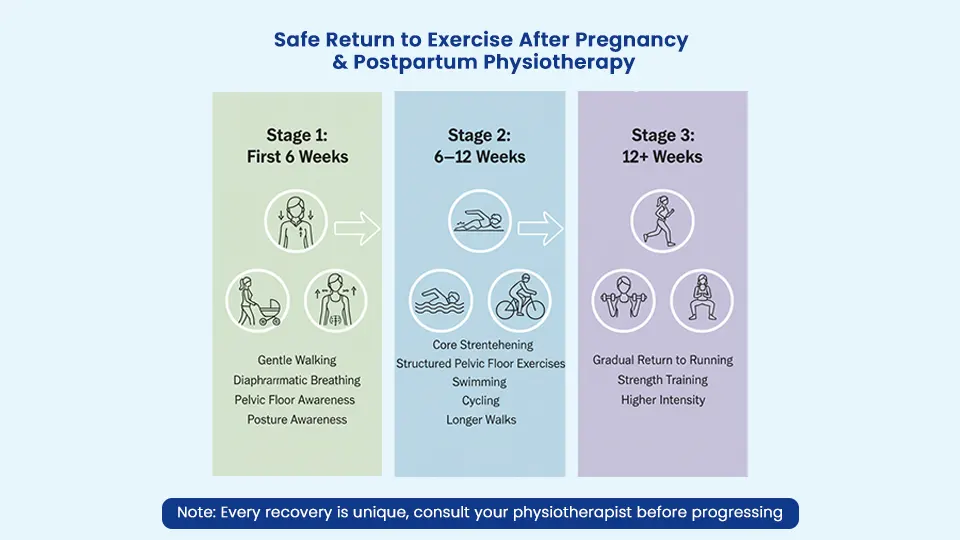
The First 6 Weeks
Focus on:
- Gentle walking (start with 5-10 minutes and gradually increase)
- Diaphragmatic breathing exercises
- Gentle pelvic floor awareness exercises (not full Kegels yet)
- Basic posture awareness
- Rest and recovery
Avoid:
- High-impact activities
- Heavy lifting beyond your baby’s weight
- Traditional abdominal exercises
- Running or jumping
6-12 Weeks Postpartum
After getting cleared by your healthcare provider:
- Begin gentle core strengthening
- Progress walking duration and intensity
- Start structured pelvic floor exercises
- Consider low-impact activities like swimming or cycling
- Work with a physiotherapist for assessment
12+ Weeks Postpartum
With pregnancy and postpartum physiotherapy guidance:
- Gradually return to more intense exercise
- Test readiness for running and high-impact activity
- Progress strength training
- Monitor for any signs of pelvic floor dysfunction
Remember, these are general guidelines. Your individual timeline may differ based on your delivery, recovery, and baseline fitness level.
Finding a Qualified Pregnancy and Postpartum Physiotherapy Specialist
Not all physiotherapists specialize in pelvic health, so it’s important to find someone with specific training and experience in pregnancy and postpartum physiotherapy.
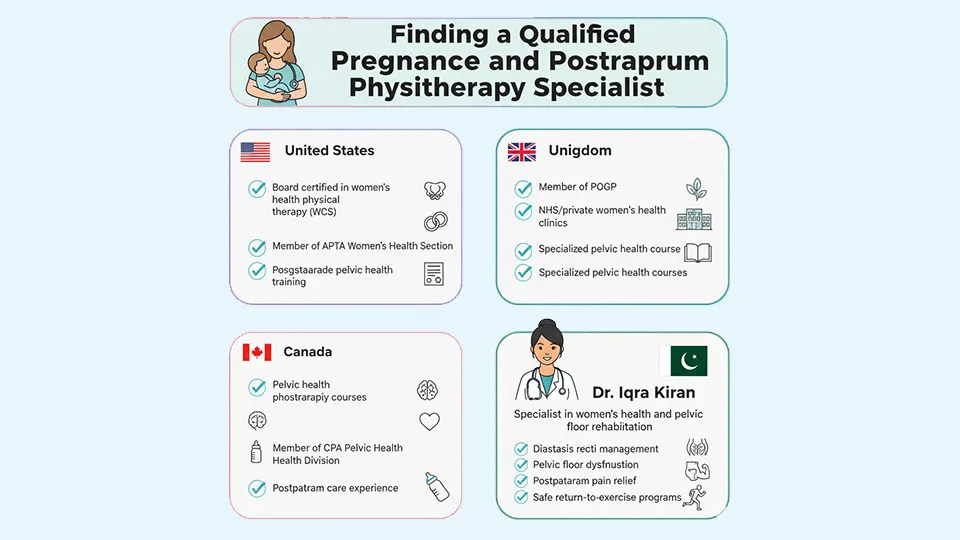
In the United States
Look for physiotherapists who are:
- Board certified in women’s health physical therapy (WCS)
- Members of the Section on Women’s Health of the American Physical Therapy Association
- Have completed postgraduate training in pelvic health
In the United Kingdom
Seek physiotherapists who:
- Are members of the Pelvic, Obstetric and Gynaecological Physiotherapy (POGP)
- Work within the NHS or private clinics specializing in women’s health
- Have completed specialized pelvic health courses
In Canada
Find physiotherapists who:
- Have completed pelvic health physiotherapy courses
- Are members of the Pelvic Health Division of the Canadian Physiotherapy Association
- Have experience in pregnancy and postpartum care
Ask potential physiotherapists about their experience with postpartum recovery, what their assessment process involves, and their typical treatment approaches.
In Pakistan
For women in Pakistan seeking specialized pregnancy and postpartum physiotherapy, Dr. Iqra Kiran is a qualified physiotherapist who specializes in women’s health and pelvic floor rehabilitation. Dr. Iqra Kiran provides comprehensive pregnancy and postpartum physiotherapy services, helping new mothers navigate their recovery journey with evidence-based treatment approaches. Her expertise includes managing diastasis recti, pelvic floor dysfunction, postpartum pain, and guiding women through safe return to exercise programs.
Insurance Coverage and Accessibility for Pregnancy and Postpartum Physiotherapy
Coverage for pregnancy and postpartum physiotherapy varies by location and insurance plan:
United States: Many insurance plans cover physiotherapy with a referral from your physician. Check your specific plan for coverage details, copays, and session limits.
United Kingdom: Postpartum physiotherapy is available through the NHS, though availability varies by area. Private options are also available.
Canada: Coverage varies by province. Some provincial health plans cover physiotherapy partially, and many private insurance plans include physiotherapy benefits.
If cost is a concern, ask about:
- Group classes for postpartum exercise
- Payment plans
- Community health center options
- Video-based programs supervised by physiotherapists
Conclusion: Prioritizing Your Recovery with Pregnancy and Postpartum Physiotherapy
Your body has done something extraordinary by growing and birthing a baby. Just as you wouldn’t run a marathon without training and expect to recover without proper care, pregnancy and childbirth deserve the same respect and attention to recovery.
Pregnancy and postpartum physiotherapy isn’t a luxury—it’s an essential component of maternal healthcare that can prevent long-term dysfunction, reduce pain, and help you feel strong and confident in your postpartum body. Whether you’re dealing with specific symptoms or simply want to optimize your recovery, working with a pelvic health physiotherapist can make a significant difference in your postpartum experience.
Don’t wait until problems become severe. Be proactive about your pelvic health, seek professional guidance, and remember that investing in pregnancy and postpartum physiotherapy is investing in your ability to fully enjoy motherhood. You deserve to feel strong, capable, and pain-free as you navigate this incredible journey.
Your postpartum body deserves expert care—consider booking a pregnancy and postpartum physiotherapy assessment today to start your recovery on the right path.
Disclaimer: This blog post is for informational purposes only and does not replace professional medical advice. Always consult with your healthcare provider or a qualified physiotherapist for personalized guidance regarding your specific situation.
FAQs About Pregnancy and Postpartum Physiotherapy
What is pregnancy and postpartum physiotherapy?
Pregnancy and postpartum physiotherapy is a specialized branch of physical therapy that focuses on treating musculoskeletal and pelvic floor conditions related to pregnancy, childbirth, and postpartum recovery. This specialized care addresses issues like pelvic pain, diastasis recti, incontinence, back pain, and C-section recovery. Pregnancy and postpartum physiotherapists have advanced training in women’s health and understand the unique physical changes that occur during and after pregnancy.
When should I start pregnancy and postpartum physiotherapy?
You can start pregnancy and postpartum physiotherapy at any point during your pregnancy or postpartum journey. Ideally, consider seeing a physiotherapist in your first trimester to learn preventive exercises, immediately if you develop pain during pregnancy, or at 6-8 weeks postpartum for a comprehensive assessment. You don’t need to wait for problems to develop preventive care is just as important as treatment.
Is postpartum physiotherapy covered by insurance?
Coverage for pregnancy and postpartum physiotherapy varies by location and insurance provider. In the United States, many insurance plans cover physiotherapy with a physician’s referral. In the UK, postpartum physiotherapy is available through the NHS, though wait times vary. In Canada, provincial health plans may cover partial costs, and private insurance often includes physiotherapy benefits. Always check with your specific insurance provider to understand your coverage, copays, and session limits.
What is diastasis recti and can physiotherapy help?
Diastasis recti is the separation of the abdominal muscles along the midline that occurs during pregnancy to accommodate your growing baby. While some separation is normal, significant gaps can persist postpartum, causing a visible bulge, back pain, and core weakness. Pregnancy and postpartum physiotherapy can effectively treat diastasis recti through specialized exercises that help the abdominal muscles come back together. A physiotherapist will assess your separation and create a progressive program tailored to your needs.
How long does postpartum physiotherapy take to work?
The duration of pregnancy and postpartum physiotherapy varies depending on your specific condition, severity, and consistency with your home exercise program. Most women see improvement within 4-8 weeks of regular treatment and exercises. Simple conditions like minor pelvic pain might resolve in a few sessions, while more complex issues like severe diastasis recti or pelvic organ prolapse may require 3-6 months of consistent work. Your physiotherapist will provide a realistic timeline based on your assessment.
Can I do pelvic floor exercises on my own or do I need a physiotherapist?
While basic pelvic floor exercises (Kegels) can be done at home, many women perform them incorrectly, which can worsen problems. A pregnancy and postpartum physiotherapy specialist can assess whether you need to strengthen or relax your pelvic floor muscles, teach proper technique, and ensure you’re doing the right exercises for your specific condition. Studies show that supervised pelvic floor training is significantly more effective than self-directed exercises alone.
What should I expect during a pelvic floor physiotherapy assessment?
During a pregnancy and postpartum physiotherapy assessment, your physiotherapist will discuss your medical history, pregnancy, delivery, and current symptoms. They’ll examine your posture, movement patterns, and abdominal muscles. With your consent, they may perform an internal vaginal examination to assess pelvic floor muscle strength, coordination, and identify any dysfunction. This internal assessment is optional, and external assessments can still provide valuable information if you’re not comfortable with internal examination.
When can I return to exercise after giving birth?
The timeline for returning to exercise after pregnancy depends on your delivery type, recovery, and baseline fitness. Generally, you can start gentle walking within days of delivery. At 6-8 weeks postpartum (after medical clearance), you can begin low-impact exercises and core strengthening with guidance from a pregnancy and postpartum physiotherapy specialist. High-impact activities like running and jumping should wait until at least 12 weeks postpartum and after a physiotherapy assessment to ensure your body is ready.
Is it normal to leak urine after having a baby?
While urinary incontinence is common after childbirth, affecting up to 45% of postpartum women, it is not normal and should not be ignored. Leaking urine when you cough, sneeze, laugh, or exercise indicates pelvic floor dysfunction that can be effectively treated with pregnancy and postpartum physiotherapy. Don’t accept incontinence as “just part of being a mom” seek help from a pelvic health physiotherapist who can assess and treat this condition.
Can physiotherapy help with C-section recovery?
Yes, pregnancy and postpartum physiotherapy is highly beneficial for C-section recovery. A cesarean section is major abdominal surgery, and physiotherapy can help with scar tissue mobilization, pain management, gradual core strengthening, posture correction, and safe return to activities. Many women don’t realize that C-section scars can cause adhesions, restricted movement, and even affect pelvic floor function if not properly addressed through specialized treatment.
How is pregnancy physiotherapy different from regular physiotherapy?
Pregnancy and postpartum physiotherapy differs from general physiotherapy in its specialized focus on the unique musculoskeletal and hormonal changes during pregnancy and postpartum. These physiotherapists have advanced training in pelvic floor assessment and treatment, understanding of pregnancy biomechanics, knowledge of safe exercises during pregnancy, and expertise in postpartum recovery. They understand conditions specific to childbearing that general physiotherapists may not be trained to treat.
What is pelvic organ prolapse and can it be treated?
Pelvic organ prolapse occurs when the bladder, uterus, or rectum drops from its normal position due to weakened pelvic floor muscles, often after childbirth. Symptoms include a feeling of heaviness, bulging in the vagina, difficulty emptying your bladder or bowels, and lower back pain. Pregnancy and postpartum physiotherapy can effectively manage prolapse through specialized exercises, pessary fitting guidance, lifestyle modifications, and teaching proper movement patterns to prevent worsening.
Do I need a referral to see a pregnancy and postpartum physiotherapist?
Referral requirements vary by location and insurance. In many US states, you can see a physiotherapist through direct access without a physician referral, though insurance may require one for coverage. In the UK, you can self-refer to private physiotherapists or request a referral through your GP for NHS services. In Canada, direct access varies by province. Check with your local regulations and insurance provider to understand your specific requirements.
Can physiotherapy help with painful intercourse after childbirth?
Yes, pregnancy and postpartum physiotherapy can effectively treat painful intercourse (dyspareunia) after childbirth. Pain during sex can result from scar tissue, pelvic floor muscle tension, weakness, or nerve sensitivity. A pelvic health physiotherapist can assess the cause of your pain and provide treatments including scar tissue mobilization, pelvic floor relaxation techniques, dilator therapy, and exercises to restore normal function. Don’t suffer in silence this is a common and treatable condition.
How soon after delivery can I start physiotherapy?
You can start gentle pregnancy and postpartum physiotherapy exercises within days of delivery, focusing on breathing, posture, and gentle movement. For a comprehensive assessment, 6-8 weeks postpartum is ideal, though you should seek immediate help if you experience severe pain, heavy bleeding, or significant concerns. If you had a C-section, gentle scar massage can begin around 6 weeks once the incision is healed. Always consult with your healthcare provider about your specific situation.
Can I do pregnancy physiotherapy virtually or online?
Yes, many pregnancy and postpartum physiotherapy services are now available through telehealth or virtual consultations. While some assessments (particularly internal pelvic floor examinations) require in-person visits, much of pregnancy and postpartum physiotherapy can be effectively delivered online, including exercise instruction, posture correction, pain management education, and follow-up appointments. Virtual physiotherapy is particularly convenient for new moms who may have difficulty leaving home with a newborn.











5 thoughts on “Pregnancy and Postpartum Physiotherapy | Pelvic Floor Therapy & Recovery”
I’ve been exploring for a little for any high quality articles or blog posts on this kind of area . Exploring in Yahoo I at last stumbled upon this website. Reading this info So i am happy to convey that I’ve a very good uncanny feeling I discovered exactly what I needed. I most certainly will make certain to don’t forget this website and give it a look on a constant basis.
wohh just what I was searching for, regards for putting up.
Great goods from you, man. I have understand your stuff previous to and you’re just extremely excellent. I actually like what you have acquired here, really like what you’re stating and the way in which you say it. You make it enjoyable and you still take care of to keep it wise. I cant wait to read far more from you. This is really a tremendous site.
I have recently started a web site, the info you offer on this website has helped me tremendously. Thanks for all of your time & work.
A person necessarily help to make significantly posts I would state. That is the very first time I frequented your website page and so far? I amazed with the research you made to make this particular put up amazing. Fantastic job!